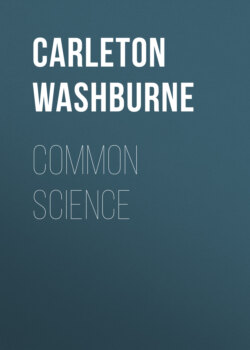Читать книгу Common Science - Carleton Washburne - Страница 44
На сайте Литреса книга снята с продажи.
Fig. 28. A lever with the weight between the fulcrum and the force.
ОглавлениеTable of Contents
Suppose you wanted to lift the pail with the least possible effort, where would you put your hand?
Notice another fact: when your hand is at the end of the yardstick, it takes the same length of time to move a long way as the pail takes to move a short way. Then which is moving faster, your hand or the pail?
Experiment 19. Put the end hole of the yardstick on the nail, as shown in Figure 28. The nail is still the fulcrum of your lever. Put the pail about halfway between the fulcrum and the other end of the stick, and hold the end of the stick in your hands.
Raise and lower your hand to see how hard or how easy it is to lift the pail from this position. Which is moving farther, your hand or the pail? Which is moving faster?
Now put your hand about halfway between the fulcrum and the pail and raise and lower it. Is it harder or easier to raise than before? Which moves farther this time, your hand or the pail? Which moves faster?
If you wanted to make the pail move farther and faster than your hand, would you put your hand nearer to the fulcrum than the pail is, or farther from the fulcrum than the pail? If you wanted to move the pail with the least effort, where would you put your hand?
Experiment 20. Use a pair of long-bladed shears and fold a piece of cardboard once to lie astride your own or some one else's finger. Put the finger, protected by the cardboard, between the two points of the shears. Then squeeze the handles of the shears together. See if you can bring the handles together hard enough to hurt the finger between the points.
Now watch the shears as you open and close the blades. Which move farther, the points of the shears or the handles? Which move faster?
Next, put the finger, still protected by the cardboard, between the handles of the shears and press the points together. Can you pinch the finger this way harder or less hard than in the way you first tried?
